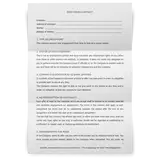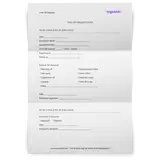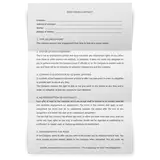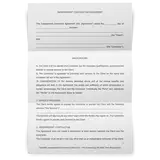So you’ve just downloaded your very first competitive analysis template and you’re excited to get started. You know that it’s important for your business, but you’re not quite sure about how it works or how to make the most of it.
If this sounds like you, you’ve come to the right place!
Let's take a look at what a competitive analysis is, why you should conduct one, and tips for using your free competitive analysis template in the real world.
Here’s a sample Competitive Analysis template that can be easily customized and adapted to meet your requirements. It’s free to download and use.
What is a competitive analysis template?
A competitive analysis template – sometimes called a “competitive market analysis template” or a “competitive analysis template business plan” – is simply a structured way of evaluating how your business compares to its competitors.
Once complete, you can then use your competitive analysis to better understand your business’s strengths, competitiveness, and market positioning. Not only that, but competitive analyses can also expose potential areas in the market that are underserved.
While competitive analyses can be conducted for the business as a whole, it is also common for marketing or product managers to conduct a competitive analysis for a specific product or service line. Alternatively, other departments may want to conduct one in order to determine how certain areas of the business compare with other companies – for example, an across-the-board evaluation of employee wellbeing programs or website performance.
Why conduct a competitive analysis?
To identify competitors
Even if you already know who your competitors are, conducting a competitive analysis forces your team to put that knowledge into writing.
By identifying and documenting your competitors in one place, your team can really zero in on the business’s main competitors and take advantage of potential opportunities. In a competitive landscape, it's important to know what makes your product offerings stand out in front of your target audience and customer base.
When doing your research, you may even identify competitors that you did not know about before! The competitive analysis process is great because it gives your team the time and space to really dive deep and identify these up-and-coming competitors before they become a threat.
You'll learn about the product features that make you stand out, as well as those that present new opportunities for growth. You'll learn about the social media presence (and online presence) of your competitors and make more informed decisions about how to beat them.
To better understand your competitors
The next reason why competitive analyses are so important is that they allow you to gain an even better understanding of who your competitors are and why they are successful (or unsuccessful).
By evaluating them based on various criteria (like marketing, logistics, financials, branding, etc.), you can get a clear picture of their strengths, weaknesses, and how they are positioned in the market.
Speaking of which, analyzing the competitive landscape helps marketing teams create customer personas, craft better product launches and eliminate potential threats in the future. By identifying competitor strengths and weaknesses, your team can come up with fresh marketing campaigns to show you in a new light.
To better understand your customers
Even though it’s called a “competitive analysis”, this type of analysis is a powerful tool that can also tell you quite a lot about your customers and the overall customer experience.
By taking a closer look at your competitors and how they serve the customers in your market, you may be able to discover new sub-markets, identify customer service preferences, or learn from your competitors’ successful branding campaigns. Tapping into customer reviews of your key competitors can help you learn a lot about who you serve and who you're competing with.
Analyzing customer behavior can lead to a better understanding of competitor profiles and the overall market landscape, as well as drive up social media engagement. Ultimately, you can use these valuable insights for your customer success team and determine what to add on your product roadmap to strengthen your market presence.
To see your position in the market.
Now that you have a better understanding of who your competitors are and how they serve a need in the market, you can then see how your own business fits into the bigger picture.
For example, do you currently serve an area of the market better than your competitors? If so, perhaps it’s a good idea to make further investments in this area in order to reaffirm your market positioning. This can help you make better business decisions, all the while following the most important market trends for your type of product.
To strategize for the future.
The ultimate goal of conducting a competitive analysis is to strategize for the future. Should you expand or eliminate a certain service line? Do you see a gap in the market that needs to be served?
Are there areas of your business that need to be improved in order to be on par with other businesses in your market? Are there social channels where you are not present enough?
There could be any number of different actions that need to be taken once your competitive analysis report template is complete. Beyond decision-making at the corporate or upper-management level, decisions could also span across multiple departments including branding, supply chain, human resources, marketing, and logistics.
Tips for using your competitive analysis template
You may have listed your indirect competitors, their marketing strategies, market share and business strategy, but you may still be wondering how to use this template. Here are some tips on how to get the most out of competitor analysis templates, be it indirect or direct competitors.
Your analysis is only as good as your data and the quality of your research.
Remember, the quality of your analysis is only as good as the information and data that comprise it. Make sure to take plenty of time to research, gather data, and completely fill in each box of your analysis with detailed answers before making any evaluations or decisions.
If research is not your expertise and you have the budget, there are plenty of research firms out there that you can hire that specialize in competitor research and analysis.
Set some objectives and expectations ahead of time
Before doing the analysis section of your competitive analysis template pdf, it’s important to try to set a few objectives and manage expectations ahead of time. What is the purpose of your analysis? What do you hope to achieve with this business model? What areas of the business do you anticipate the outcomes of this analysis to impact?
By setting some objectives, your team can stay focused and grounded in the purpose of the project. For example, business owners can understand why their marketing plan should be focused on content marketing rather than Google Ads.
Be fair in your evaluation
Evaluating your performance against your competitors isn’t always easy. Whether we like it or not, business can get personal, and it can be very difficult to take ownership of our weaknesses and admit it when our competitors are excelling in certain areas.
Despite this, it is still important to remain fair and unbiased in your competitive analysis and evaluation process for your target market. If you find that this is particularly challenging for your team, consider bringing on board an external consultant to help you navigate the competitive analysis process – especially if you are evaluating your business as a whole.
Identify specific action points – and follow up
There is no point in conducting a competitive analysis if you have no intention of making any practical changes in your business. That being said, it’s not necessary to change everything about your business after seeing the results of your competitive analysis.
Instead, try to come up with four or five high-priority areas to focus on going forward. Beyond that, always make sure to follow up with the relevant stakeholders and responsible parties to ensure real action is taken and progress is being made.
Analyzing customer feedback not just from your target customers, but also from your major competitors can help your sales and marketing efforts. It helps spot industry trends, market gaps and reveals opportunities for business growth.
Update your analysis regularly
No matter what your industry is, the world and your market are constantly changing and evolving at pace. Therefore, your competitive analysis should be a living document that is updated regularly.
If you have conducted a competitive analysis for the company as a whole, it is a good idea to keep updating it on a quarterly or annually basis. If you are a marketing or product manager looking to keep an even closer eye on your competitors, this document can be updated daily or weekly depending on how fast your specific market is changing.
If you want to drive your search engine optimization efforts, Google Ads or social media strategy, keeping track of your competitor overview is crucial.
![Competitive Analysis Template [Free Download]](/static/image?src=https%3A%2F%2Fcdnblog.unrubble.com%2Fpayload-unrubble-images%2FCompetitive-Analysis-Template-600x600.png&width=512&height=512&fit=contain&position=center&quality=65&compressionLevel=9&loop=0&delay=100&crop=null&contentType=image%2Fwebp)




